Mongolian Beef
This post may contain affiliate links. Read my full disclosure policy.
From The Woks of Life cookbook, this crispy Mongolian beef is every bit as good as the version served at your favorite Chinese restaurant.
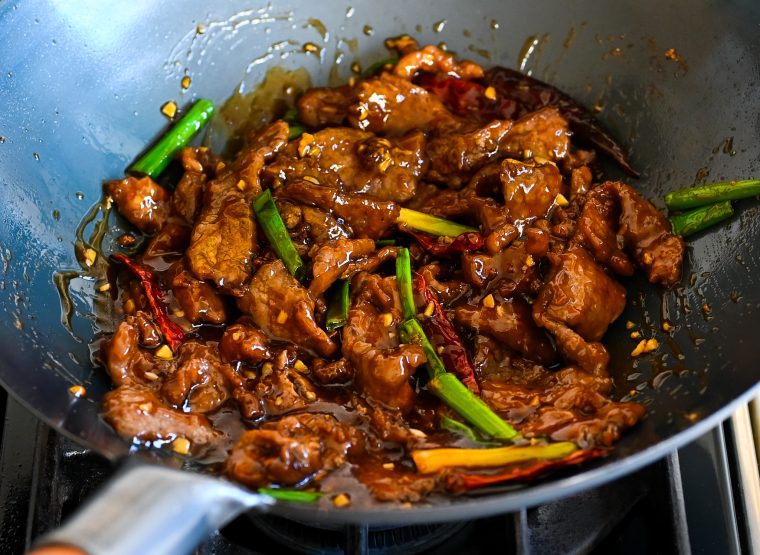
Mongolian beef is a popular Chinese-American restaurant dish that consists of tender, crispy beef in a savory-sweet brown sauce. This version comes from The Woks of Life, written by Bill, Judy, Kaitlin, and Sarah Leung, the family behind the popular Woks of Life blog. I’m a big fan of the cookbook and the blog, both of which are excellent resources for anyone interested in learning more about Chinese cooking.
To prepare the dish, thinly sliced flank steak is first “velveted” or tenderized by marinating it in a mixture that includes baking soda, before being coated in cornstarch. The beef is then shallow-fried in a wok or skillet until crispy, and tossed in a flavorful brown sauce made with soy sauce, brown sugar, garlic, ginger, and scallions. Served over steamed rice, the dish is a huge family-pleaser and every bit as good as the Mongolian beef served at your favorite Chinese restaurant.
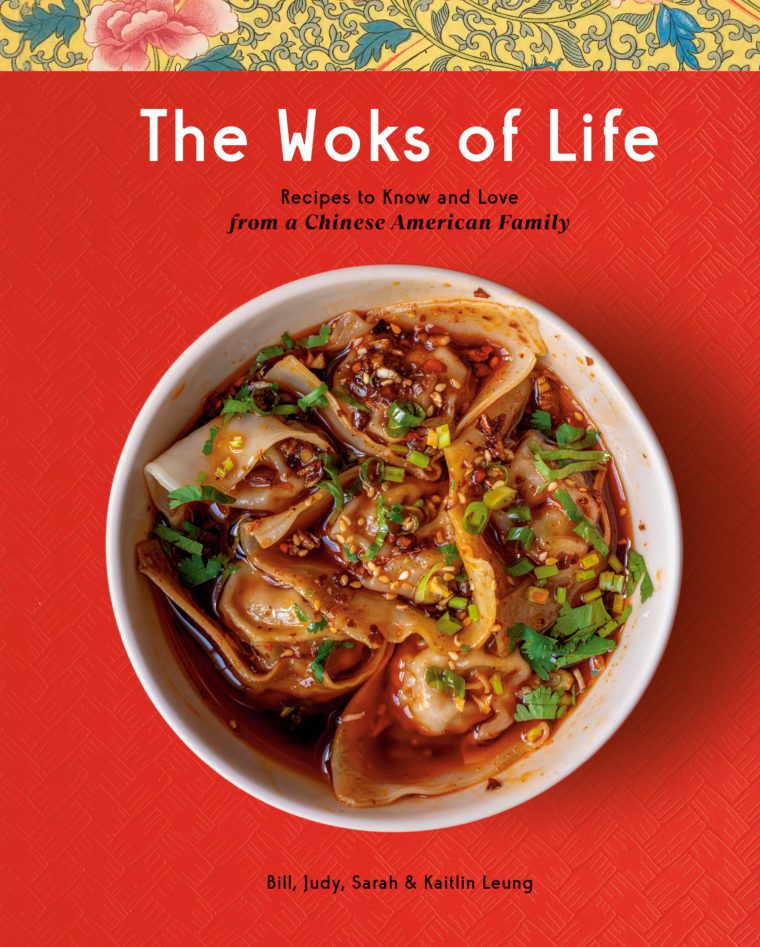
Table of Contents
What You’ll Need To Make Mongolian Beef
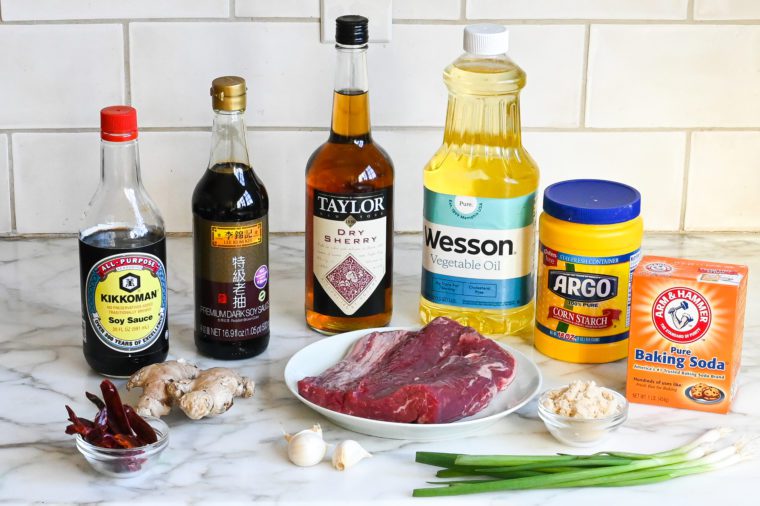
- Soy sauce: Two kinds are called for: regular and dark soy sauce. Dark soy sauce is saltier, sweeter, and a bit thicker than regular soy sauce. It used to flavor dishes and also darken the color of sauces, and you only need a small amount. You can find it at Asian markets or online. If you don’t have any, you can simply omit it but your dish will be lighter in color. Alternatively, you can make a substitute by combining 2 teaspoons soy sauce, 1/2 teaspoon molasses, and 1/8 teaspoon sugar.
- Cornstarch: Used for thickening, dredging, and binding in Chinese cooking. As a thickener, cornstarch needs to be dissolved in water before adding it to simmering liquid. It makes more robust, glistening, visually appealing sauces. Cornstarch also works well in batters and crispy coatings, and helps seal in juices of meat before cooking, resulting in tender meat.
- Shaoxing wine: A type of Chinese rice wine that helps give Chinese food its distinctive flavor. Dry sherry can be substituted.
- Dried whole red chili peppers: A common ingredient in Chinese cooking, these peppers are made by drying fresh red chili peppers until they become hard and brittle. You can usually find them in the produce section at the supermarket.
- Baking soda: Used in Chinese cooking as a meat tenderizer. When mixed with water, baking soda creates an alkaline solution that can break down the tough fibers in meat, making it more tender. The process of using baking soda to tenderize meat is known as “velveting.”
- Jump to the printable recipe for precise measurements
Step-by-Step Instructions
Slice the flank steak against the grain into ¼-inch-thick slices.
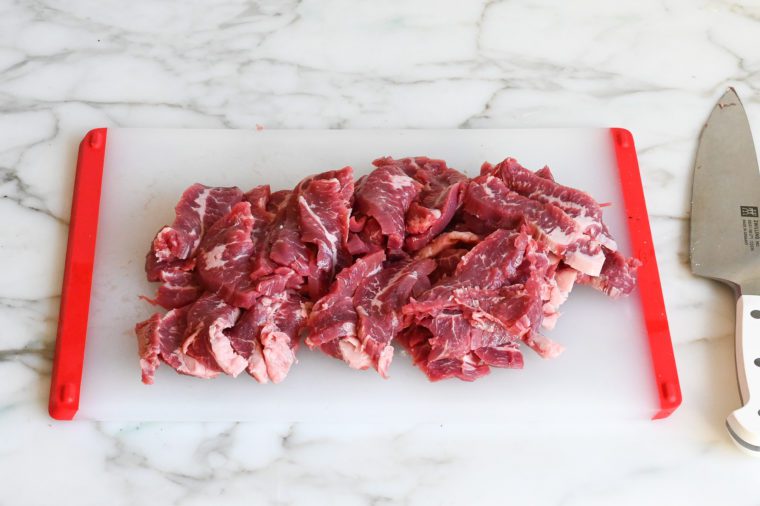
In a medium bowl, combine the Shaoxing wine (or dry sherry), soy sauce, cornstarch, water, and baking soda.
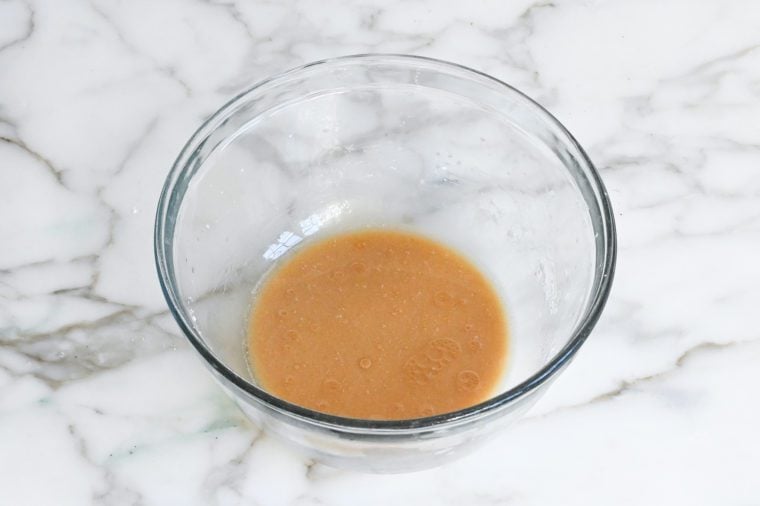
Add the beef and stir until evenly coated.
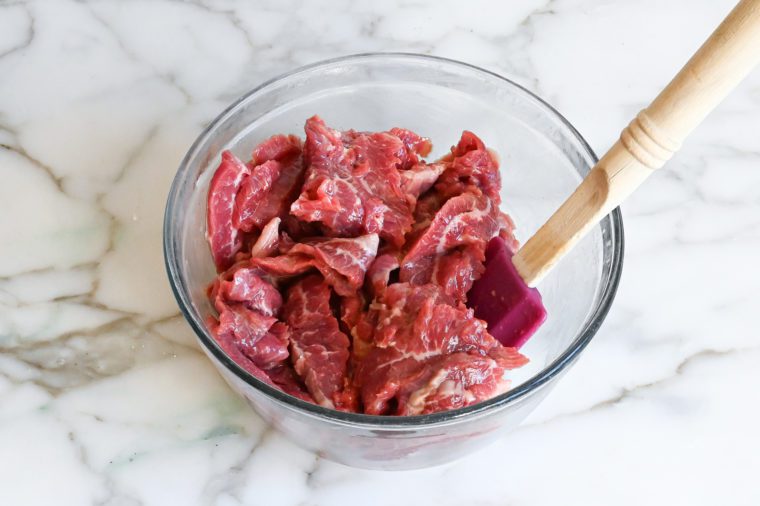
In a small bowl, dissolve the brown sugar in the hot water. Mix in the regular soy sauce and dark soy sauce.
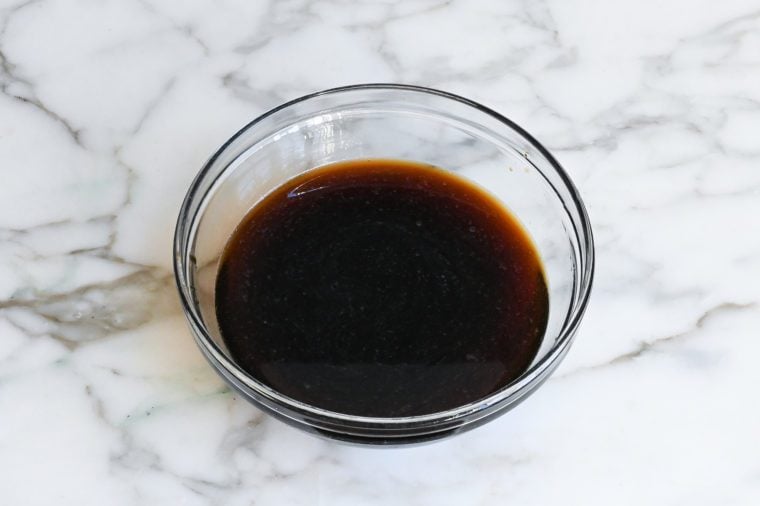
Slice the scallions and mince the garlic and ginger.
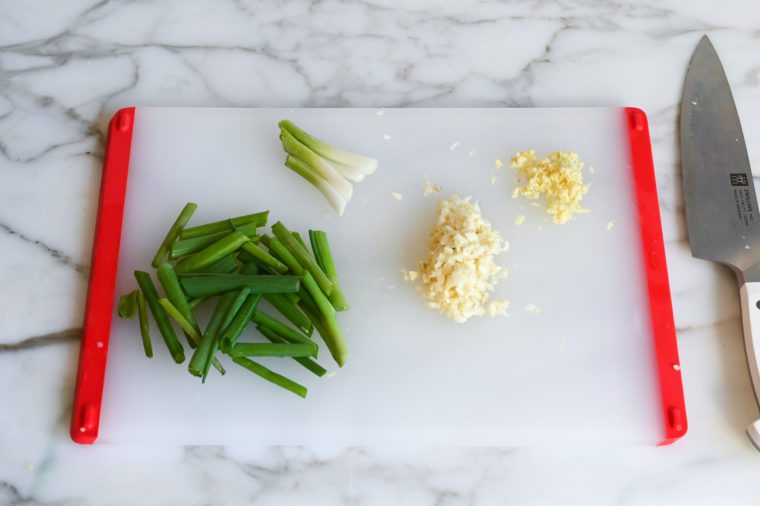
In a medium bowl, dredge the marinated beef slices in the ½ cup cornstarch until thoroughly coated.

Heat the oil in a wok or large nonstick skillet over high heat until just before the oil starts to smoke. Working in batches so as not to crowd the pan, spread the beef slices evenly in the wok or skillet and shallow-fry them undisturbed for 1 minute on each side to achieve a crusty coating. Transfer the beef to a plate and turn off the heat.
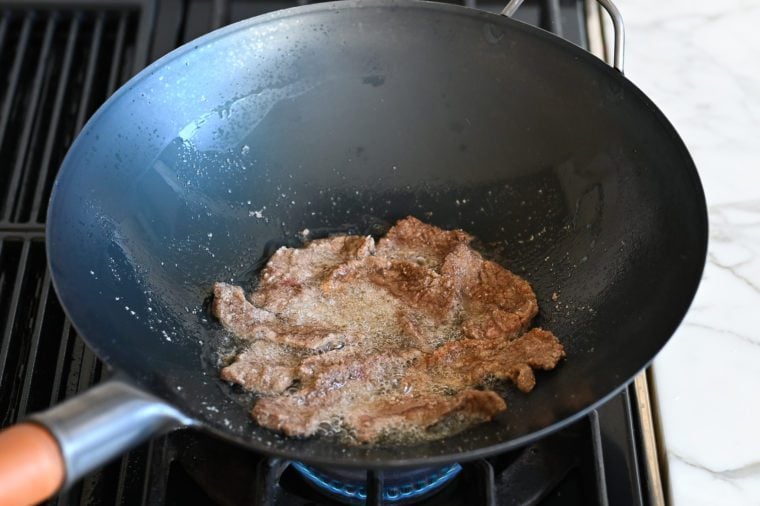
Drain most of the oil from the pan, reserving 1 tablespoon. Wipe the pan with a paper towel, then add the reserved tablespoon of oil. Over medium-high heat, add the ginger and whole dried chilies (if using).
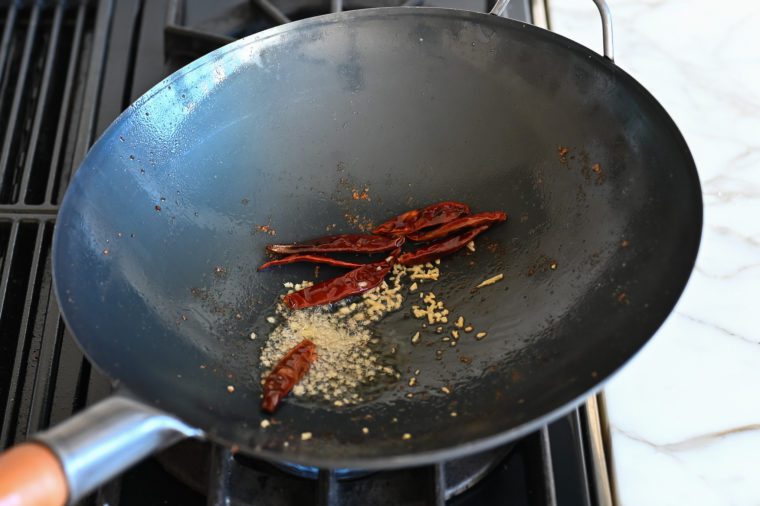
After 15 seconds, add the garlic and the scallion whites. Stir-fry for another 15 seconds.
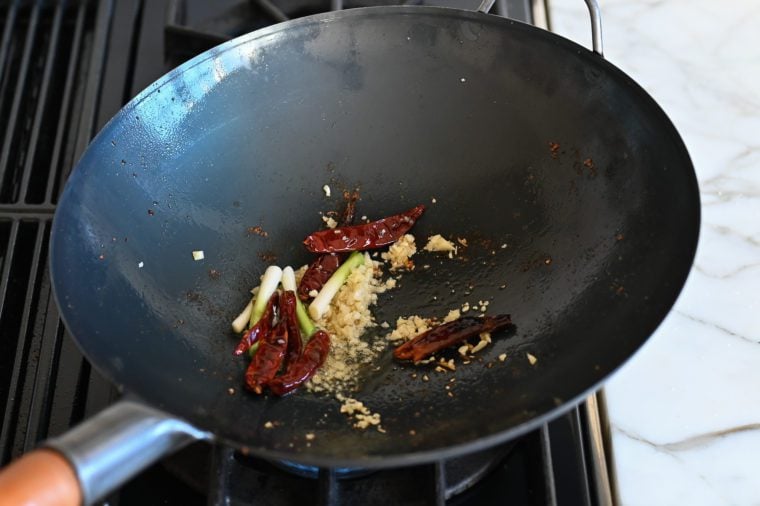
Add the sauce and simmer for 2 minutes.
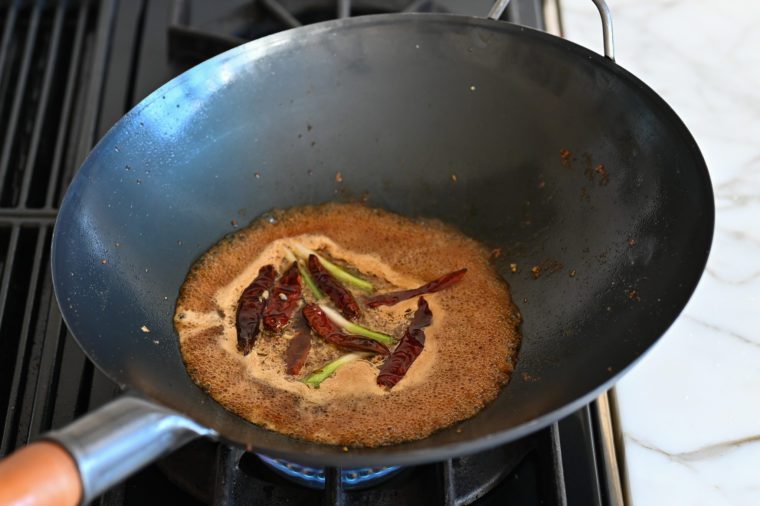
Combine the cornstarch with the water to make a slurry, then slowly stir it into the pan.
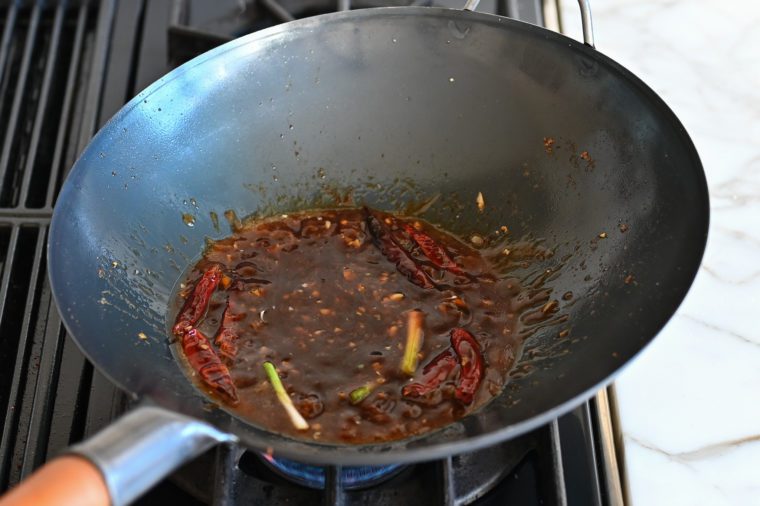
Add the beef and the green parts of the scallions.
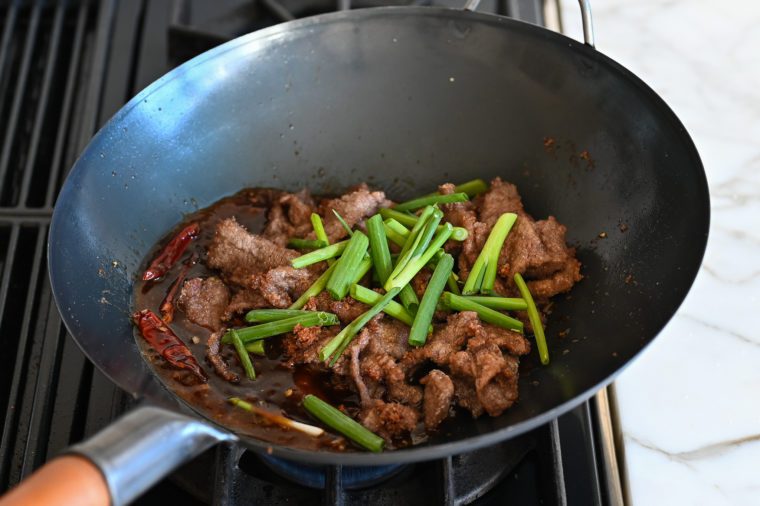
Toss everything together for 30 seconds, until the scallions are wilted and there is almost no standing sauce. Serve.

You May Also Like
Mongolian Beef
From The Woks of Life cookbook, this crispy Mongolian beef is every bit as good as the version served at your favorite Chinese restaurant.
Ingredients
For Marinating the Beef
- 1 pound beef flank steak, sliced against the grain into ¼-inch-thick slices
- 2 teaspoons vegetable (or neutral) oil
- 2 teaspoons Shaoxing wine (or dry sherry)
- 1 teaspoon regular soy sauce
- 1 tablespoon cornstarch
- 1 tablespoon water
- ¼ teaspoon baking soda
For the Sauce
- ¼ cup (packed) light brown sugar
- ¾ cup hot water
- ¼ cup regular soy sauce
- 1 teaspoon dark soy sauce (see note)
For Coating and Searing the Beef
- ½ cup cornstarch
- ⅔ cup vegetable (or neutral) oil
For the Rest of the Dish
- 1 teaspoon minced fresh ginger
- 8 dried red chilies (optional)
- 3 medium garlic cloves, finely chopped
- 4 scallions, white and green parts separated and cut on an angle into 2-inch pieces
- 1½ tablespoons cornstarch
- 2 tablespoons water
Instructions
Marinate the Beef
- In a medium bowl, combine the beef with the oil, Shaoxing wine (or dry sherry), regular soy sauce, cornstarch, water, and baking soda. Marinate for 1 hour.
Make the Sauce
- In a small bowl, dissolve the brown sugar in the hot water. Mix in the regular soy sauce and dark soy sauce.
Coat and Sear the Beef
- In a medium bowl, dredge the marinated beef slices in the ½ cup cornstarch until thoroughly coated.
- Heat the oil in a wok or large nonstick skillet over high heat until just before it starts to smoke. Working in batches so as not to crowd the pan, spread the beef slices evenly in the pan and shallow-fry them undisturbed for 1 minute on each side to achieve a crusty coating. Transfer the beef to a plate and turn off the heat.
Assemble the Dish
- Drain most of the oil from the pan, reserving 1 tablespoon. Wipe the pan clean with a paper towel, then add the reserved tablespoon of oil. Over medium-high heat, add the ginger and whole dried chilies (if using—if you’d like the dish spicier, break 1 or 2 chilies in half). After 15 seconds, add the garlic and the scallion whites. Stir-fry for another 15 seconds. Add the sauce and simmer for 2 minutes.
- In a small bowl, combine the cornstarch with the water to make a slurry, then slowly stir it into the pan.
- Add the beef and the green parts of the scallions. Toss everything together for 30 seconds, until the scallions are wilted and there is almost no standing sauce. Serve.
- Note: Dark soy sauce is saltier, sweeter, and a bit thicker than regular soy sauce. It is used to flavor dishes and also darken the color of sauces, and you only need one to two teaspoons. Dark soy sauce is available at Asian markets or online. If you don’t have any, you can simply omit it. However, your dish will be lighter in color. If you want your dish to look like the photograph, don’t leave it out. (Alternatively, you can make a substitute by combining 2 teaspoons soy sauce, ½ teaspoon molasses, and ⅛ teaspoon sugar.)
Pair with
Nutrition Information
Powered by ![]()
- Per serving (4 servings)
- Calories: 760
- Fat: 60 g
- Saturated fat: 10 g
- Carbohydrates: 31 g
- Sugar: 9 g
- Fiber: 1 g
- Protein: 25 g
- Sodium: 1,149 mg
- Cholesterol: 70 mg
This website is written and produced for informational purposes only. I am not a certified nutritionist and the nutritional data on this site has not been evaluated or approved by a nutritionist or the Food and Drug Administration. Nutritional information is offered as a courtesy and should not be construed as a guarantee. The data is calculated through an online nutritional calculator, Edamam.com. Although I do my best to provide accurate nutritional information, these figures should be considered estimates only. Varying factors such as product types or brands purchased, natural fluctuations in fresh produce, and the way ingredients are processed change the effective nutritional information in any given recipe. Furthermore, different online calculators provide different results depending on their own nutrition fact sources and algorithms. To obtain the most accurate nutritional information in a given recipe, you should calculate the nutritional information with the actual ingredients used in your recipe, using your preferred nutrition calculator.

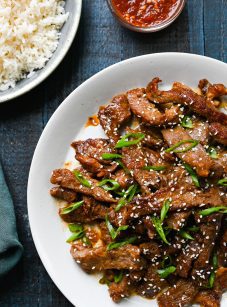


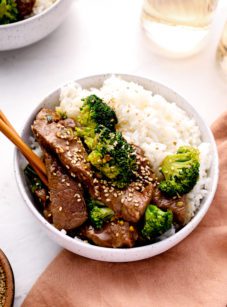
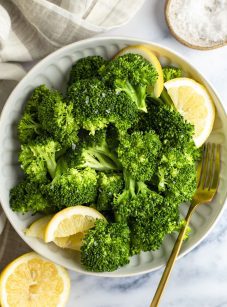
I’m not good at cooking beef, so I rarely cook it. But after using this recipe, you would thought I was an expert. It was really delicious, the beef was tender, although I didn’t use the recommended cut and my son thoroughly enjoyed it. Thanks so much Jenn, I really enjoy your recipes and this one is a keeper. Actually I’m going to cook it again today.